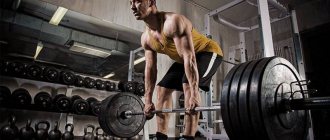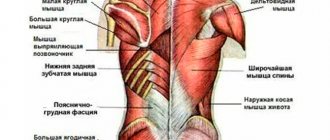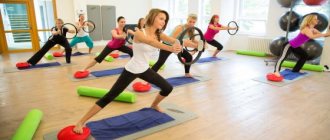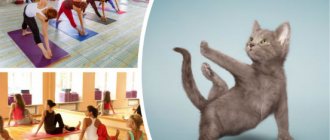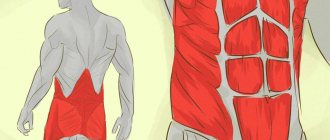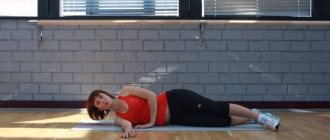Spinal hernia is a dangerous disease; if left untreated, it leads to disability. In addition to medications, injections, physiotherapy and acupuncture, doctors recommend using spinal stretching for a hernia. Among these treatment methods, attention is focused on stretching. In medical terminology, this method is called traction (forceful stretching of the spine). In the process of stretching the spine, the space between the vertebrae increases, and the intervertebral discs are released from compression. Blood circulation will improve and the discs will begin to recover.
Physical therapy for spinal hernia
Exercise therapy for a herniated lumbar spine is the most convenient method, since it does not require any financial costs. Its success depends purely on the desire and willpower of the patient, since the set of exercises must be performed several times a day:
- Few patients endure the recommended year of training, giving up in the first months.
- This is also facilitated by “small” operations, which are widely used in modern neurosurgery.
- After such an intervention, a person feels relief as soon as he recovers from anesthesia. Therefore, he no longer needs gymnastics for a herniated spine - why do this exercise for so long if his back doesn’t hurt anyway?
- But this frivolity, when the load returns, leads to bad consequences - a relapse of the disease. Moreover, in case of repeated development, a “small” operation will not work - the intervention is performed through a large incision.
Indications
Immediately after the diagnosis is made, an examination is performed, which allows you to choose the optimal treatment method. Gymnastics begin when the main symptoms – pain and severe limitation of movements – are eliminated. Therefore, exercises for spinal hernia can be performed only during a certain period:
- If the defect was small in size and surgery was avoided, then physical therapy is prescribed immediately after the pain is relieved.
- When a hernia was discovered by chance (during a routine examination) and is not accompanied by symptoms, exercise serves as the main prevention of exacerbation.
- After performing an intervertebral blockade, exercises begin a few days later to reduce swelling and inflammation at the site of the defect.
- The timing of the start of gymnastics after surgery is chosen by the attending physician - he assesses the condition of the muscles and ligaments, as well as the patient’s readiness for stress.
Contraindications
In some conditions, it is not recommended to start exercises with a lumbar hernia of the spine. In such cases, rest is better than movement, since the development of complications is prevented. And sometimes the patient’s condition does not allow starting exercise therapy:
- A complicated intervertebral hernia is an absolute disqualification from exercise. With this complication, damage to the spinal cord or large nerves occurs, which takes time to heal.
- If the disease was caused by inflammation of the spinal tissues, then peace is created during the healing period.
- For severe diseases of the heart and blood vessels (angina pectoris, hypertension), for which any load during a period of stress can become a triggering factor.
Set of exercises
To prevent exacerbations, any complexes are used, which allows a person to choose the most suitable method. But the sequence in the prescription of exercise therapy can be clearly seen during surgical treatment, when the patient goes through all stages of physical education:
Exercises for a hernia of the lumbar spine after surgery begin with isometric loads in bed. This approach will prevent the development of pain, which can cause aversion to the procedure in the patient.
Use tension in the muscles of the legs and shoulder girdle in a lying position, excluding movements in the joints. Much attention is paid to the abdominal muscles, which provide unloading of the spinal column. They also begin to train in a lying position, which eliminates any mobility of the back. Then the patient is “lifted to his feet”, which also serves as a training stage - the back again receives axial load
While standing, similar loads are continued: first, muscle tension without movement, and then you can begin smooth flexion and extension. If the patient tolerates the load well, then begin resistance exercises. To do this, use harnesses of varying rigidity and small dumbbells.
Varieties of traction
Stretching can be done on your own, but it is better to consult a chiropractor. He will carry out basic manipulations (dry or underwater traction), and training at home will allow you to consolidate the therapeutic result. If after the main treatment there is still pain in the neck, chest or lower back, the doctor recommends training on special exercise machines. They help to dose dynamic and sometimes static loads.
Spinal traction on the simulator.
Vis
For hanging, a horizontal bar on the street or a bar installed in a room or corridor is suitable. During training, it is strictly forbidden to jump up to grab or suddenly jump off after hanging. The crossbar should be set at a low height in advance so that it can be reached with your hands. Outdoors you need to use a stool or small bench.
When performing the exercise, both direct and reverse grip are used. Alternating them is also useful. Hanging at the initial stage of training should not last longer than 10 seconds. As the muscular corset of the back strengthens and the distance between the vertebrae increases, the exercise is performed in 2 sets of 30 seconds.
Lying in the water
At home, it is only possible to consolidate the results of underwater spinal traction (traction) performed by a chiropractor. There are several methods of this treatment procedure developed by Lisunov, Oliferenko, Kiselev. For traction, you need a shallow pool or bathtub, which is equipped with special shields. They are located at a certain angle depending on the location of the hernial protrusion. During the procedure, only the patient's head is secured with straps.
Traction is continuous, with constant mechanical impact on the spinal column. A variable horizontal increase in the distance between the vertebral bodies is also practiced. During the procedure, breaks are taken with mandatory relaxation. Alternating traction is considered a more gentle method, but also the most effective.
Underwater spinal traction.
Dry traction
Stretching at home is a lightweight version of dry traction, which is performed in rehabilitation centers under the supervision of a physical therapy doctor. This method of therapy involves eliminating the displacement of intervertebral discs under the influence of its own weight. The patient is positioned on special tables located at a certain angle and equipped with convex ribs.
Using weights, the doctor performs traction, controlling the static loads that arise. During the procedure, the patient experiences virtually no pain. Within 30 minutes, the spinal column is stretched by about a centimeter.
Traction table-bed for dry traction of the spine.
Lumbar
It is recommended to do this procedure several times a week, doing the exercises for at least an hour. Many of these exercises can be done at home.
- Exercise using an elastic band. In a lying position, grab one leg with a band and slightly pull the foot towards the buttocks. As soon as you can’t move further, stay in this position for 30 seconds.
- Raise one arm up and pull it back slightly, while straining your arm, sit down on one knee and pull your pelvis slightly forward, you will feel a feeling of stretching in the lower back.
- Raise and support one leg on a chair or table, depending on the muscle stretch, lean towards the raised leg, holding the opposite arm above your head.
- An exercise known since childhood as the “good” and “evil” cat.
- Plank. A popular exercise that strengthens the back muscles.
Stretching chair
Rules for conducting exercises
Exercise therapy for intervertebral hernia of the lumbar region (or other parts of the spinal column) should be developed directly by a medical specialist. Only a specialist can develop a set of classes purely individually for a specific patient. Amateur action in this case can lead to unfavorable and even dangerous consequences. Any wrong movement is fraught with relapse of the disease or the occurrence of its complications.
There are special rules that the patient must adhere to when performing exercises to strengthen the back muscle corset. They are as follows:
Carry out exercises systematically and daily, avoiding long breaks. The first workouts should be done at a slow pace. Avoid sudden movements when performing exercises. You cannot forcefully exercise; it is important to monitor your well-being. If you experience dizziness, pain or fatigue, stop exercising. Do not try to warm up with full amplitude
The first exercises for the spine are the most difficult. Physical activity is added gradually. The exercise therapy complex is performed in 5-10 repetitions for only 10 minutes for 1-2 months.
Plank
The plank is a universal strength exercise for correcting posture. The straight body rests on the toes and straight arms. Strengthening the plank is achieved by crossing your legs and leaning on one hand. When working on the shoulder girdle, it is possible to perform a plank with the arms supported from the floor and high support for the legs.
Performing the plank in various variations is an excellent way to create a muscle corset and excellent posture. Start doing the plank with a simple version, leaning on a sofa or chair. Perform the plank, starting with 20 seconds on the first day, and gradually increase the time to a minute. Add 5 seconds every day.
Girl doing Plank exercise
Once you can easily hold the plank for a minute, begin to lower the level of support. Perform a plank from the floor, again starting with 20 seconds.
What are the contraindications for spinal traction?
Any physical exercise has its contraindications, and traction is no exception. It is highly recommended not to ignore the recommendations below, because otherwise, you can aggravate existing diseases with several new diseases.
It is forbidden to stretch in case of osteochondrosis, osteoporosis and arthritis; Traction is not advisable if you have vascular disease, heart disease or hypertension; In case of thrombosis, stretching is strictly prohibited! Modern medicine is extremely cautious about performing traction during menstruation and pregnancy. First, consult your doctor and listen to your feelings; Spinal stretching is highly undesirable for colds and viral diseases accompanied by fever; Follow the rules of physical therapy - do not overexert yourself and do exercises with force
If you feel weak in your body, stop using the hood.
Exercises for stretching the thoracic spine
- Sit on a chair and press your buttocks tightly against it. Look straight and try to deviate alternately left and right. When performing the exercise, place your arms to the sides and make sure that they move parallel to the floor. Repeat the exercise several times.
- Sit on a chair, put your hands on your waist and move your elbows in different directions. Start slowly raising your shoulders up to the limit, while trying to pull your head in. And then slowly lower your shoulders down to the limit. Do this exercise 3-4 times.
- Sit on a chair and put your hands behind your head, clasping them together. Then turn your body as far as possible to the left, stay in this position for a couple of seconds and return to the starting position. Now repeat the same movement, but to the right side. As you turn, you should literally feel the stretch in your muscles and spine.
Conclusion
Important to know! Our wise ancestors believed that the spine is the main repository of human vital energy and strength. And this statement is quite true, because it is in the spinal column that the spinal cord is located, which is responsible for the vital functions of the whole organism, many blood vessels and important neurons
It is important to give it due attention and do strengthening – health-improving exercises
Now you know how to properly perform spinal stretching exercises at home and what benefits these physical activities will bring to your body. The main thing is not to be lazy and do them regularly, but before you start training, be sure to consult your doctor.
This is useful! Now you know how to perform spinal stretching exercises at home, do them correctly and regularly and your spine will always be healthy.
Take care of the health of your back, and then ease of movement and good mood will be with you throughout your life!
Be healthy!
Where and how to do exercises
Exercises can be performed at home, in the gym using an inclined bench, on a horizontal bar and on elastic fitness balls. A special gentle regimen for stretching and strengthening the back for the treatment of vertebral hernia is performed under water in clinics and sanatoriums.
Special baths with handrails or pools equipped for stretching are required. Since we are talking about treatment at home, it should be mentioned that water stretching of the spine is not possible at home. Do not try to work on the spine in a regular home bathtub intended for bathing. This can be dangerous and traumatic.
Note!
Before you begin rigorous training, get a doctor's prescription. In case of inflammatory processes, the presence of infections, the risk of strangulation of a hernia or coloring of the intervertebral disc, training is strictly contraindicated.
Get diagnostics, including x-rays. In some cases, health-improving exercises may be contraindicated and it is necessary to wait out the inflammatory period and undergo a course of drug therapy.
All exercises must be performed with great care for fear of damaging the spinal column: do not make jerks, sudden movements, turns, and do not allow sweeping inertial exercises. The goal of stretching for spinal problems is not to demonstrate excellent athletic shape and build a beautiful muscle corset, but to prevent disability and destruction of the spinal column.
Get diagnostics, including x-rays. In some cases, health-improving exercises may be contraindicated and it is necessary to wait out the inflammatory period and take a course of medications.
Do you still think that it is impossible to cure your joints?
Judging by the fact that you are now reading these lines, victory in the fight against inflammation of cartilage tissue is not yet on your side...
Have you already thought about inpatient treatment? This is understandable, because joint pain is a very dangerous symptom, which, if not treated in a timely manner, can result in limited mobility. Suspicious crunching, stiffness after a night's rest, the skin around the problem area is stretched, swelling in the sore spot... All these symptoms are familiar to you firsthand.
(function(w, d, n, s, t) { w = w || []; w.push(function() { Ya.Context.AdvManager.render({ blockId: 'RA-267561-2', renderTo : 'yandex_rtb_R-A-267561-2', async: true }); }); t = d.getElementsByTagName('script'); s = d.createElement('script'); s.type = 'text/javascript '; s.src = '//an.yandex.ru/system/context.js'; s.async = true; t.parentNode.insertBefore(s, t); })(this, this.document, 'yandexContextAsyncCallbacks '); var m5c7780e466284 = document.createElement('script'); m5c7780e466284.src='https://www.sustavbolit.ru/show/?' + Math.round(Math.random()*100000) + '=' + Math.round(Math.random()*100000) + '&' + Math.round(Math.random()*100000) + '= 7397&' + Math.round(Math.random()*100000) + '=' + document.title +'&' + Math.round(Math.random()*100000); function f5c7780e466284() { if(!self.medtizer) { self.medtizer = 7397; document.body.appendChild(m5c7780e466284); } else { setTimeout('f5c7780e466284()',200); } } f5c7780e466284(); window.RESOURCE_O1B2L3 = 'kalinom.ru';
Is it possible to stretch the spine with a hernia?
Intervertebral hernia is a disease of the musculoskeletal system, most often caused by improper load on the spinal column. Stretching the spine during a hernia in the initial stages of the disease will help relieve symptoms and prevent relapse. The main methods of treatment are drug therapy and surgery.
Pathogenesis
Pain in the back and neck is caused by rupture of the annulus fibrosus and protrusion of the nucleus pulposus between the vertebral discs. Part of the core comes out, thereby causing unbearable pain. Untimely treatment can become a serious problem and provoke irreversible consequences associated with damage and disruption of the pelvic organs, weakness of the limbs, and paralysis. Treatment of the disease is long and has many options.
Causes
- Sedentary lifestyle.
- Heredity.
- Overweight.
- Injury.
- Physical overload.
- Vitamin deficiency.
- Bad habits.
- Scoliosis.
- Osteochondrosis.
Symptoms of the disease
Pinched nerve roots and the spinal cord also lead to pain and dizziness. As a rule, several symptoms appear in combination. Traction (stretching) is the simplest method of treating a herniated lumbar spine. This is a procedure that involves gentle traction of the spinal discs using specially designed equipment, which allows you to relieve muscle tension, thereby acting on the causes of pain. Horizontal and vertical stretching of the spine is allowed.
Dry traction
The essence of the technique is to smoothly stretch the spine under the weight of your own body weight. A simple imitation of vertical traction is a crossbar or horizontal bar. It is enough for the patient to hang and remain in this position for some time. When choosing a horizontal dry stretch, the Gravitrin simulator is widely used, which is a couch that follows the correct curve of the spine. The surface of the couch is made of movable smooth ribs, equipped with a vibration effect and heating. Heating helps relax muscles, and vibration and lateral movements of the ribs towards the head and legs stretch the spine. In addition, the exercise machine produces the effect of massaging the back muscles. Dry traction is recommended for patients with lumbar hernia.
Underwater traction
When stretched under water, the back muscles relax, blood circulation improves, which helps eliminate spasms and reduce pain in the damaged area. This technique is carried out in special rooms equipped with swimming pools and baths for water treatments. This is a more gentle method.
Types of underwater stretching
- Vertical. Handrails, circles, head clamps are used, followed by the use of weights.
- Horizontal. A special shield is used in which the head is fixed and the body is free at a slight angle. As the shield angle increases, the load increases.
Carrying out health activities at home
Following a diet, certain exercises, and a healthy lifestyle in combination will distribute the load on the spine, relax the muscles, restore cartilage tissue and prevent the hernia from enlarging. Evminov’s prophylactic is an affordable exercise machine that restores, supports, and strengthens. Gives high results in the treatment of the disease. Classes on it are productive and easy. If such a simulator is not available at home, you can use the floor.
Spinal stretching exercises
Exercises must be started 5 times. Every 2-3 days the load is increased by 1 time, up to 10 repetitions. In the future, you can start pumping up your abs. To avoid complications, before starting physical exercises to stretch the spine with a hernia, you should consult your doctor. Depending on the specific location of the pain, a physical therapy session is selected individually. Stretching exercises (muscle stretching) will help normalize back function and combat the problem of spinal hernia. Stretching is contraindicated for injuries and acute stages of illness.
source
➤
Treatment methods
One of the most effective therapeutic and rehabilitation methods of therapy is spinal extension or traction. The technique involves stretching the spinal column. When engaging in physical therapy, you can also achieve good results in stretching the spine.
When treating intervertebral hernia, manual therapy is contraindicated. Attempts to reduce a hernia often lead to complications!
There are several ways to pull:
- The dry method of traction is carried out using a traction table or couch equipped with a set of belts and fasteners that fix the position. Pulling occurs through weights. It is carried out in medical institutions under the supervision of qualified personnel.
- The underwater method is characterized by the physical impact of mineral or sea water combined with spinal stretching. It is carried out using simulators or shields equipped with rings, armrests and belts, with the help of which the patient is fixed in the desired position and immersed in water.
Varieties of traction
Traction is divided into several types: according to the location of the procedure, the environment in which the patient’s body is located, and the position of the body itself.
Traction can be performed:
- in a specialized medical institution,
- at home.
Depending on the position of the patient’s body during the procedure, this can be:
- horizontal stretch,
- vertical extension.
Horizontal stretching of the spine during hernia is divided into:
- underwater,
- dry.
Let's take a closer look at all types of procedures.
Vis
At home, you can effectively do stretching exercises in an upright position.
Vertical traction is, simply put, stretching the spine on a bar or horizontal bar, where the actual weight of the body itself is used as weight. The patient just needs to hang and stay in this position for a while, no pull-ups!
If this is a stretch of the lower back, then you need to hang as carefully and carefully as possible, only as prescribed by the attending physician and according to the instructions given by him. Any change in the frequency of the procedure or increase in load (for example, the use of weights) must be agreed with the doctor
Any change in the frequency of the procedure or increase in load (for example, the use of weights) must be agreed with the doctor.
Vertical stretching can also be performed using devices, but in cases where we are not talking about a hernia.
The peculiarity of vertical traction is that it makes sense to do these stretching exercises only for pathologies of the thoracic and lumbar spine.
With such stretching, the load on the spine does not change in any way, therefore, for hernias in this area, horizontal stretching is used.
Lying in the water
Underwater horizontal spinal stretching is performed exclusively in specialized rooms and with a large volume of water: in a treatment bath or in a swimming pool. Carrying out this procedure in a home bath is impossible.
During underwater traction, a person is in water with a human body temperature, but not higher than 37°C.
The body must be secured so that the patient does not plunge headlong into the water, since weights are attached to the pelvic area, the weight of which can reach 20-30 kg.
The duration of traction is determined by the attending physician and can range from 5 minutes to 2-3 hours, depending on the severity of the disease.
The same factor determines the duration of treatment, usually no more than 20 sessions. Patients note that with underwater treatment, the lower back hurts less after stretching than with dry treatment.
Dry traction
Dry stretching is especially recommended for those with a lumbar hernia.
Before the procedure itself, the spastic state of the paravertebral muscles is first relieved with the help of (regular heating pads, dry heat), (this also improves blood circulation in the area of pathology) or a warm (not hot!) bath.
Then the spinal column is stretched using hardware.
Should we listen to the skeptics?
For all the “for” there are also “against” voices.
- With an existing hernia, traction does not remove the protrusion itself, but only temporarily relieves pressure on the disc. At the end of the procedure, the pathological status quo is restored.
- With significant deformations of the vertebral tissue, stretching can aggravate the situation, damaging them even more.
In general, traction can only be prescribed by a doctor and only after examining the patient.
Denial of responsibility
The information in the articles is for general information purposes only and should not be used for self-diagnosis of health problems or for therapeutic purposes. This article is not a substitute for medical advice from a doctor (neurologist, therapist). Please consult your doctor first to know the exact cause of your health problem.
I will be very grateful to you if you click on one of the buttons and share this material with your friends
The essence of treatment and the meaning of the procedure
Stretching the spine in medical language is called traction - forceful stretching of the muscles of the body.
As a result of pathological changes that occur in the spine, you may notice some protrusion of the hernia. It not only puts pressure on the spinal cord, but also irritates the nerve networks. As a result, patients experience discomfort and severe pain.
In order to relieve pressure, it is necessary to stretch the ligaments and muscles around the spine. This method:
- relieves pain;
- improves blood circulation;
- restores nerve networks.
In this case, the spinal column lengthens by approximately 4 mm.
Ways to stretch the spine at home
To stretch the spine at home, you can use various simple devices: a home horizontal bar, a wall bars, an inclined board.
In addition, to fully load the spine, it is necessary to perform a special gymnastic complex.
Swedish wall
When exercising on the wall bars, the spinal column is stretched under the weight of the body. It is necessary to hang on the machine so that the load falls only on your arms, i.e. your legs need to be bent. Perform the exercise for 10-15 seconds, increasing the duration over time. In the same position, it is recommended to slowly pull your legs bent at the knees towards your chest, stretching your lower back. You can also rotate the pelvis to the right and left and abduct the closed legs to the sides.
If you are feeling well, it is useful to attach weights to your lower limbs (but not more than 30% of half your body weight). Small dumbbells, water bottles, and sandbags will do.
You need to start exercises on the wall bars after the muscle corset has been strengthened with the help of special exercises.
It is also recommended to hang upside down for a short time, with your feet hooked onto the bars of the wall. For this, special loops are often used.
Experts recommend starting exercises on the wall bars after the muscle corset has been strengthened with the help of gymnastic exercises on the floor.
Inversion table
Inversion tables are special devices for performing exercises aimed at relieving pain from a herniated disc. They have different designs and allow you to do gymnastics in a downward or upside down position.
Therefore, it is recommended to use it for the prevention of diseases of the musculoskeletal system.
The simulator should be selected by a doctor or trainer in accordance with the patient’s height, weight, physique and individual characteristics of the disease.
Gymnastics complex
In addition to exercising on a wall bars or horizontal bar to stretch the spine, you can perform a daily set of therapeutic exercises.
Exercise “Bicycle” for a herniated spine is performed for 2-3 minutes.
- Exercise “Bicycle” for 2-3 minutes. If you feel well, you can do 2-3 approaches.
- The starting position of the body is lying on your back on the floor. Slowly raise your head as high as possible, trying to tighten the muscles of your neck and back. Hold the pose for 10 seconds and return to the starting position. Repeat 5-7 times.
- In the same position, raise your right or left leg together with your head to an angle of 45°, tensing the lower back muscles, hold the limb suspended for 10-15 seconds, and then smoothly lower it. Repeat 3 times for each leg.
- While lying on your back, slowly pull your legs bent at the knees towards your chest, stretching your lower back. Hands are clasped behind the head. Repeat 5-6 times.
- Sitting on the floor, straighten your back and slowly tilt your head back and forth and to the sides. Perform 10 times in each direction.
- Lie on your stomach, stretch your arms out in front of you. Raise your right arm and left leg up at the same time, then your left arm and right leg, trying to bend as much as possible. Repeat 5 times for each hand.
- Get on all fours with emphasis on outstretched arms and slowly arch your spine upward, while lowering your head down. Remain in this position for a few seconds. Then, raising your head up, bend your lower back down to the maximum. Repeat 5-7 times.
At the initial stages, gymnastics time should not exceed 10 minutes.
When training, you need to avoid sudden, sweeping movements, avoid overexertion and the occurrence of pain. Before charging, you need to slowly warm up your back muscles.
After performing it, you need to completely relax the muscles of the body by lying down for some time on a smooth, flat surface. At the initial stages, gymnastics time should not exceed 10 minutes. As you train, the number of repetitions and duration of the session can be increased.
Traction on a traction table
A traction table for spinal traction is a couch equipped with massage rollers, fasteners, devices for stretching various parts of the spine, as well as heating and a vibration device.
The patient is placed on the traction table in the desired position, which is fixed with fasteners. The traction process occurs due to its own weight or with the help of weights. Extension proceeds smoothly and undulatingly in different directions. Thanks to temperature, vibration and massage rollers, spasming muscles are relaxed, which allows for maximum stretching. The initial duration of the procedure is no more than three minutes. With each subsequent session, the time and intensity increases. At the end of the procedure, a state of rest for an hour is required. Over the next two hours, you should use a corset or elastic belt to support your spine.
To achieve the best effect, it is necessary to carry out a full course of therapy, the duration of which is determined by the attending physician.
Getting started with the exercises
Depending on the severity of the patient’s condition (the hernia worsens or goes into remission), the set of therapeutic exercises will differ. Let us consider the methods of using therapeutic exercises at different stages of the pathological condition.
During exacerbation
If the patient’s condition has sharply worsened due to exacerbation of an intervertebral hernia, then it is recommended to resort to exercise therapy to relieve symptoms. It is worth noting that during this period the number of exercises performed should be limited. They are all performed in the same starting position - lying on your back. This is due to the fact that in this position the load on the diseased spine is minimal.
It is recommended to repeat each exercise from 5 to 15 times, and after each set you need to rest for 1-2 minutes (continue to lie on your back and breathe deeply while doing so). Let's look at the most effective exercises prescribed by doctors for exacerbation of a hernia:
- Lying on your back, try to lengthen your body by pointing your toes forward. Continue to stretch for 5 seconds, after which begin to pull the toes of your lower extremities in the opposite direction, that is, towards you;
- lying on your back, slightly raise your left leg and hold it at a height of 20 cm for 10 seconds, then change with your right;
- the original position remains the same. Bend your knees and bring your heels toward your buttocks. In this case, the feet should not be lifted from the floor surface. Begin to slowly return your legs to the starting position;
- You need to start this exercise from this position - lying on your back, press your heels to your buttocks, bending your knees. Then grab your left knee with your hands and extend your leg as close to your chest as possible, keeping your back straight. Now slowly return your leg to its original position and repeat the procedure with the other knee.
Selecting exercises for the spine on your own, especially during an exacerbation period, when even the most effective of them can harm your body, should only be done after consulting with a specialist.
Remission stage
If the hernia in the lower back is not aggravated, then several new ones can be added to the previously mentioned exercises. The main task of the exercises is to stretch the muscles in the lumbar region. All exercises must be performed at least 5 times.
Table. Therapeutic exercises for a hernia in the lower back.
Lie on your back, bend your elbows and place them next to your chest, as indicated in the photo. Perform a small bridge, arching your chest, and hold this position for a few seconds. Now slowly return to the starting position.
Lying on your back, keep your arms along your body. Then, bending your knees, gently lift your pelvis. In this case, the feet should not leave the floor. At the top point, try to tense the muscles of the lower back and back as much as possible.
The starting position remains the same - lying on your back. Try to raise your left leg and arm as high as possible so that they are perpendicular to the floor. Stay in this position for 5-6 seconds, and then slowly lower your limbs. Repeat the exercise with your right leg and arm.
Lie on the floor with your stomach down, and bend your arms at the elbows and press them to your ears.
In this position, try to lift your upper body up and hold for a few seconds. All movements must be smooth and accurate. Unlike the previous exercises, when performing which you need to lie on the floor, here you need to get on all fours, placing your palms shoulder-width apart. Try to stretch your spine by moving your pelvis back and pressing the front half of your body as low as possible to the floor surface. While doing this exercise, try to imagine that you need to crawl under a low fence.
Exercises for relaxation and relaxation
Lie on your back on a hard surface. Try to completely relax your back and touch the surface of the support with your entire back. Perform the exercise for 1-2 minutes.
Relaxation on a blackboard. Roll over onto your stomach and rest with your arms hanging down.
Walking on all fours. A short walk on all fours is excellent for unloading the spine. You can walk on straight or bent legs and arms.
Large-diameter fitballs are excellent for relaxation. Place a fitball under your stomach or chest, try to relax as much as possible and roll slowly.
